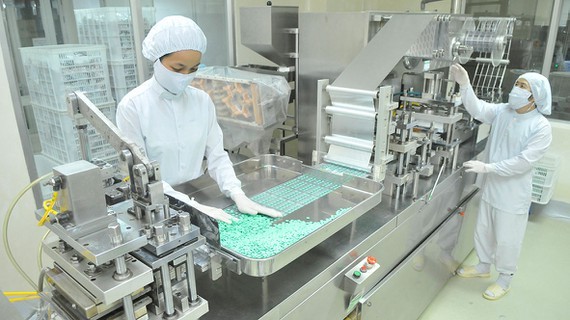
Assessing the export market, the Ministry of Industry and Trade (MoIT) said that, with 13 free trade agreements that Vietnam has already signed, the doors to many key markets have been wide open for Vietnamese goods. Especially, with the EU-Vietnam Free Trade Agreement, the main export products of Vietnam, such as plastics, textiles, footwear, and agricultural and aquatic products, almost have no competitors. Because export tariffs on some Vietnamese goods will immediately retreat to zero or follow a three-year to seven-year tariff reduction schedule. Meanwhile, the same types of export goods in other countries that have not signed an FTA with the EU are currently being imposed tariffs from 3 percent to 22 percent. The export tax rate will be even higher, even up to 100 percent, if the products of those countries are under trade remedies and anti-dumping investigations.
From the beginning of September to now, Vietnamese exporters have received lots of good news. Mr. Nguyen Thanh Binh, Chairman of the Vietnam Fruit and Vegetable Association, enthusiastically shared that not only have export orders been resumed in many markets around the world, but many batches of goods have also met the origin criteria and enjoyed the export tax incentive of zero percent. For instance, the batch of 100 tons of passion fruits of Dong Giao Export Food Joint Stock Company exported to the Netherlands enjoyed an export tax of zero percent, applied under the EVFTA’s regulations. Or the Vina T&T Group successfully exported an order of 20,000 fresh coconuts to the European market with an export tariff of zero-percent.
According to Mr. Binh, the internal strength of domestic enterprises has continuously improved in recent years. At the end of last year, Vietnam was among the top ten countries with the highest export turnover in the world. In the strategic and traditional markets of Vietnam, such as the US, Europe, Japan, and South Korea, Vietnamese products always have a stable consumption market share and continuously post growths over the years. Vietnam's export goods have also transformed, from mainly exporting raw materials to high-value and branded products.
From the beginning of the year until now, although the world economic situation has experienced turbulence, export orders have been interrupted in many markets, enterprises have still managed to maintain their export capacity. The representative of the MoIT said that in the first nine months of this year, the export turnover was estimated at US$202.86 billion, up 4.2 percent over the same period last year. There are 30 items with an export turnover of over $1 billion, accounting for 91.3 percent of the total export turnover. Of these, there are five export products with an export turnover of more than $10 billion. Specifically, phones and accessories hit $36.7 billion; electronics, computers, and components reached 32.2 billion; garments and textiles touched $22.1 billion; machinery, equipment, tools, and spare parts got $18.2 billion; footwear gained $12.1 billion. Especially, the proportion of export turnover in the first nine months of this year recorded a sharp increase in the sector of domestic enterprises, topping $71.83 billion, up 20.2 percent, and accounting for 35.4 percent of total export turnover. Foreign direct investment sector, including crude oil, reached $131.03 billion, down 2.9 percent, accounting for 64.6 percent of total export turnover.
To achieve such results, domestic enterprises have prepared carefully for entry to fastidious markets. Besides investing in upgrading production lines, production technology, and improving product quality, product management from production to consumption is also given special attention. The representative of Dong Giao Export Food Joint Stock Company said that the company had to establish a passion fruit growing area in Gia Lai Province under the GlobalGAP standards. Besides, products are tightly managed from planting, harvesting, and processing to transportation and consumption. Consumers can trace the origin of products through packing. Vina T&T Group added that besides the above factors, fruit processing, and packing factories also apply standards, such as ISO and HACCP. Especially, to secure the foothold in fastidious markets, the company must focus on developing deeply-processed products.
The agricultural sector has many advantages, thanks to the availability of local raw materials, but other major export sectors do not have such advantages. Mr. Tran Viet Anh, Chairman of the Ho Chi Minh City Plastics Association, said that the plastic industry has many opportunities to export to the EU, thanks to the preferential export tax of zero percent from August 1, 2020. In the US market, Vietnamese products are dominating because of their highly competitive prices. However, enterprises are still facing difficulties because most of raw materials must be imported from Iran and Thailand. Since the beginning of this year, the source of imported raw materials has been continuously interrupted, the prices have also surged sharply by 10-30 percent. Raw materials from the Middle East, which are usually cheap and plentiful, encounter difficulty in payment. This has lost many opportunities for market development of the enterprise.
Acknowledging the trend of developing export markets in the coming time, many enterprises said that the consumption in the market is being compressed. Therefore, as soon as the pandemic is under control, there will be an explosion in the purchasing power of people around the world. This is an opportunity for domestic enterprises to boost exports and quickly recover internal production resources if there is good preparation from now.
Accordingly, enterprises need to quickly improve the production technology, prepare the sources of raw materials, in which prioritizing domestic raw materials, and ensure the supply capability for large orders that require fast delivery. As for the State Bank of Vietnam, it is necessary to consider increasing the foreign exchange reserve ratio to meet the increasing demand for imported raw materials when the other countries control the pandemic, which is expected to be mid-2021. Especially, in the process of customs clearance, the electronic system must be thoroughly applied to shorten the time of customs clearance, creating opportunities for enterprises to quickly send imported raw materials to production, as well as goods to export markets.
























